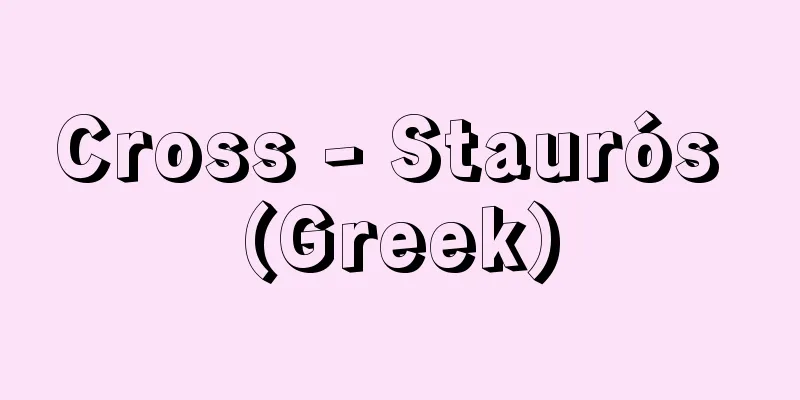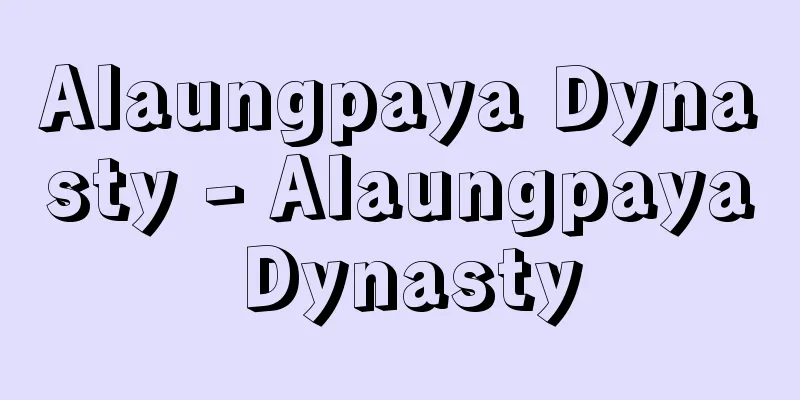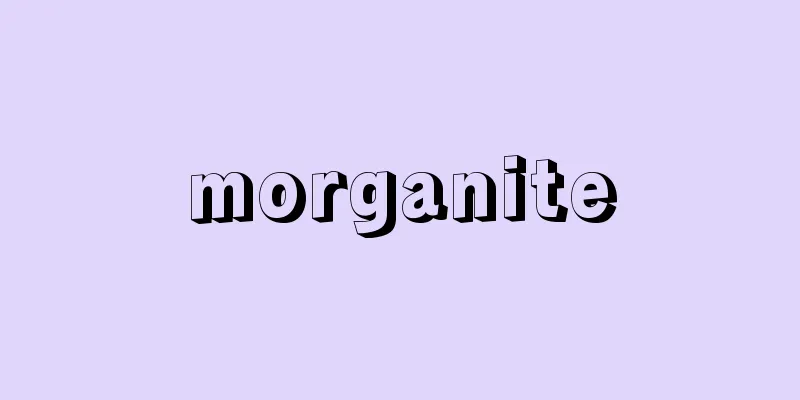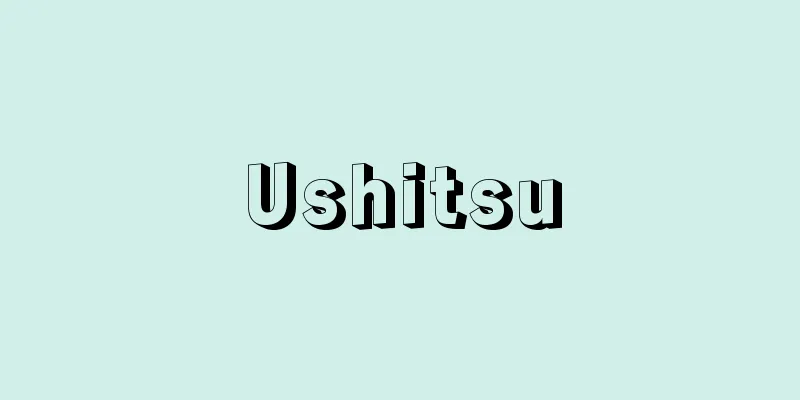Cross - Staurós (Greek)

|
An instrument of execution consisting of a wooden cross, on which Jesus Christ was executed, and which became a symbol of Christianity. [Norihisa Suzuki] Freedom from suffering, death, and sinThe method of execution, in which the body of a criminal was tied to a cross and sometimes the hands were nailed to it, was practiced in ancient countries including Phoenicia. In Rome, it was used for slaves and violent criminals. Jesus was crucified along with two robbers by Pilate, the Roman governor who ruled over Judea. This shows that Jesus was treated as a lowly person and was subjected to the most severe punishment. In the Gospels, which are biographies of Jesus in the New Testament, the word cross is already used to mean burdens and suffering (Matthew 10:38, 16:24). It can also mean enduring a shameful death or humiliation (Hebrews 12:2). In the Epistles of Paul in the same New Testament, it means the death of the old and liberation from sin, as in "My old man has been crucified with Christ" (Romans 6:6). It is said to be a sign that the self that was caught up in worldly things and fleshly desires has died and been given a new world of life. In the Book of Ephesians and the Book of Colossians, the idea of atonement that Jesus' death on the cross is reconciliation with God can be seen (Ephesians 2:16, Colossians 1:20). The fact that the cross was used as a symbol of Christianity can be seen from the fact that its shape was painted on the walls of churches built in underground cemeteries (catacombs) during persecution. There is a famous story that Emperor Constantine saw a sign of a cross in the sky and the words "Win with this sign" and used the cross as a military flag. [Norihisa Suzuki] Object of worshipThe cross soon became not only a symbol of Christianity, but also an object of worship. At first, only the cross was placed on the altar, but later, it came to be accompanied by a statue of Christ crucified. The statue of Christ was crowned, and we can see a transition from Christ as a victor over sin and death to Christ suffering as atonement for the salvation of mankind. The Friday before Easter is considered the day of the Crucifixion, or the day of the Passion, when Christ was crucified, and in the Roman Catholic Church, a ceremony is held in which the person kisses the cross. The ritual of making the sign of the cross with the fingers involves reciting "In the name of the Father, the Son, and the Holy Spirit," and is performed in the order of forehead, chest, left shoulder, and right shoulder in the Roman Catholic Church, and forehead, chest, right shoulder, and left shoulder in the Eastern Church. Making the sign of the cross is considered to be equivalent to a sacrament of receiving God's grace. In addition, the cross is sometimes used to exorcise demons. Protestants, however, do not make the sign of the cross, nor do they worship crucifixes. [Norihisa Suzuki] Source: Shogakukan Encyclopedia Nipponica About Encyclopedia Nipponica Information | Legend |
|
十字に組み合わせた木を用いた処刑の道具。これによりイエス・キリストが処刑されたことから、キリスト教の象徴になる。 [鈴木範久] 苦難や死・罪からの解放十字架に罪人の体を縛り付け、ときには両手を釘(くぎ)で打ちつけたりする処刑方法は、フェニキアをはじめ古代諸国で行われていた。ローマでは、奴隷や凶悪犯に使われた。ユダヤ地方を治めていたローマ総督ピラトにより、イエスは強盗犯人2人とともに十字架で処刑された。このことは、イエスが卑しい人間の扱いを受け、極刑に処せられたことを表す。『新約聖書』のイエスの伝記である福音書(ふくいんしょ)では、十字架ということばが、早くも重荷・苦難などを意味するものとして用いられている(「マタイ伝福音書」10章38、16章24)。あるいはまた、恥多き死や屈辱に対する忍耐(「ヘブル書」12章2)を表すこともある。同じ『新約聖書』の「パウロの書簡」になると「わたしの内の古き人はキリストと共に十字架につけられた」(「ロマ書」6章6)のように、古きものの死、罪からの解放を表すものになっている。この世的なるものや肉の情欲にとらわれていた自己に、死んで新しい生の世界が与えられたことのしるしとされる。「エペソ書」や「コロサイ書」では、イエスの十字架の死が、神との和解であるという贖罪(しょくざい)思想がみられる(「エペソ書」2章16、「コロサイ書」1章20)。 十字架をもってキリスト教の象徴としたことは、迫害下に地下の墓地(カタコンベ)に設けられた教会の壁などに、その形が描かれていることでわかる。コンスタンティヌス帝が、空に十字架のしるしと「このしるしで勝て」と書かれた文字を見て、十字架を軍旗としたという話は名高い。 [鈴木範久] 礼拝の対象十字架は、やがてキリスト教の象徴であるだけにとどまらず、礼拝の対象となった。初めは十字架だけが祭壇に置かれたが、のち、キリストの磔(はりつけ)像を伴うようになった。そのキリスト像には王冠をつけ、罪・死に対する勝利者としてのキリストから、人類の救済のため、贖罪の苦難のキリストへ、という変遷もみられる。 復活祭前の金曜日は、キリストが十字架につけられた受難日、受苦日とされ、ローマ・カトリック教会では十字架に接吻(せっぷん)する儀式が執り行われる。指で十字架のしるしをつくる儀礼は、「父と子と聖霊の御名(みな)によりて」を唱え、ローマ・カトリックでは額、胸、左肩、右肩の順、東方教会では額、胸、右肩、左肩の順でなされる。十字架のしるしを切ることは、神の恩寵(おんちょう)にあずかる秘蹟(ひせき)(サクラメント)に準ずるものとされている。また、ときには、十字架が悪魔払いに用いられることもある。なお、プロテスタントでは、この十字架のしるしをつくらないし、十字架像を崇拝の対象とすることもしていない。 [鈴木範久] 出典 小学館 日本大百科全書(ニッポニカ)日本大百科全書(ニッポニカ)について 情報 | 凡例 |
Recommend
Naomoto Tachibana
Date of birth and death unknown. A Chinese poet o...
Ion Valence - Ion Ka
The amount of electricity an ion possesses divide...
Newly hatched larva
The term refers to the larvae of silkworms immedia...
Kumagai Taizo - Bear is a tiger
A medical scientist born in Nagano Prefecture. He...
Curve Salvation - Kyokusenkyukoku
... In October of that year, Wuhan was occupied b...
Morgan, GT (English spelling) Morgan GT
… The chemistry of complexes, which was establish...
Kisei [town] - Kisei
An old town in Watarai County in the central south...
Hyderabad (English spelling)
The capital of Andhra Pradesh in southern India, l...
Naja haje (English spelling)
… [Takahiro Matsui]. … *Some of the terminology e...
Temporary Division - fig
…Between summer and winter there is a special per...
Sillimanite (English spelling)
Its chemical composition is Al 2 SiO 5 . It is an ...
Datemaki - Datemaki
〘 noun 〙① A narrow obi that women wear to keep the...
Zatougane - Down payment
Also called mekuragane (blind money), this refers ...
Lu Zuqian
A scholar from the Southern Song Dynasty in China...
Red small flathead beetle - Red small flathead beetle
… Flat grain beetles are 2-5mm long. Many species...









